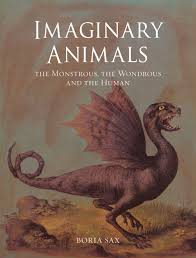Review: Imaginary Animals November 29, 2013
Author: Beach Combing | in : Ancient, Contemporary, Medieval, Modern, Prehistoric , trackbackAny parent will know that animals are important. Children make animal sounds before they make words. They draw and paint animals. They cherish animal toys. The books they read have animal characters. They pretend to be animals. Animals, in fact, become a kind of meta-language for their experience and their emotions: Little Miss Beach has changed ‘favourite animal’ three times in the last months from dragon, to wolf, to bat and these changes have gone hand in hand with her evolving personality; she is now five and a half. All this leads us to Boria Sax’s latest book: Imaginary Animals: The Monstrous, the Wondrous and the Human (Reaktion Books). What do you expect from a book entitled Imaginary Animals? Beach, had he not known something of the author, would have guessed an A-Z of the peculiar and bestial, something taxonomic and ordered. But that subtitle is the proof that the book has, instead, attitude. Yes there are chapters on the Unicorn, on ‘Shape Shifters’ and on ‘Creatures of Water’: which suggests a taxonomy of sorts. But there is also a chapter on ‘What is an ‘Imaginary Animal’? and ‘Every Real Animal is Imaginary’ and, the fundamental, ‘Every Imaginary Animal is Real’. Then, even the ‘taxonomic’ chapters are far more than that offering a blend of different reflections not just consecutive sections on habitat, diet and plumage/skin colour. They are written to show the way that animals have fuelled the human imagination. We are back to humanity’s oldest meta language.
The discussions are not sharp or systematic, but gentle and zen-like. At least for the present blogger this is a compliment. In such a vast, messy field, it makes much more sense to string bits of pearl together rather than to build lego cities out of other people’s arguments. So in ‘Creatures of Water’ we have the following subtitles: ‘From the time before time’, ‘Tiamat’ (the Lovecraftian monstrous), ‘The mother of all monsters’, ‘Sedna’ (an Inuit water mother bogey who deserves a home in every swimming pool), ‘Heroes and leviathans’ and ‘The mermaids and her sisters’. Now, yes, a river runs through it. There is a common watery thread, but there is no mounting symphony of waves and no thunderous, crashing conclusion on the beach. This is what history should be: walking along the strand and picking up whatever curiosity catches your eye. No one’s blood pressure is going to go up reading this book, the style is amenable and the debates stimulating but never demanding.
Beach had a couple of disappointments, as is inevitable in three hundred pages. He was shocked to see Derrida make an entree, though it was worth Derrida’s brief incursion to read Donna Haraway pulp this blog’s least favourite French philosopher. There were mentions of fairies but there was no real in depth analysis, not even in relation to Paracelsus: perhaps Doc Sax’s next book, he has what it takes to write a cracker. There were also some freaky sentences: e.g. ‘I find it easy to imagine that animals may at times allow themselves to be taken as prey for a variety of reasons, including weariness, curiosity and empathy with predators’. That example may sound silly in isolation, but read in context it is almost credible, which might give you a sense of how curious this book really is. However, to those ‘disappointments’ (sun spots personal to Beach) let’s add a bit of superlative praise for the illustrations. BS has put together the most impressive selections of drawings, paintings, sketches and photographs I have ever seen in this field. Anyone who has put a book like this through the printer will know how difficult it is to find a hundred plus of the ‘right’ pictures. If you didn’t read a word the purchase price would be repaid in the pleasure that those pictures would give you. Well done, Boria and well done Reaktion!
Any other unusual but quality books? drbeachcombing AT yahoo DOT com



